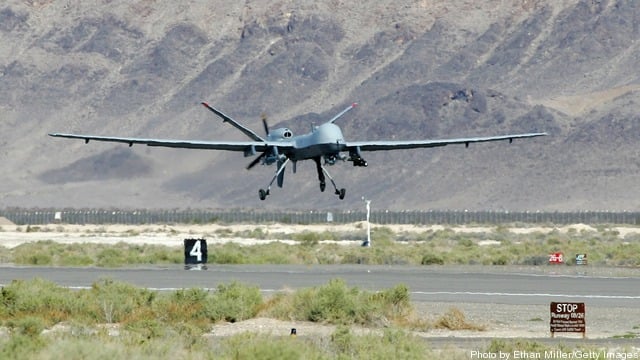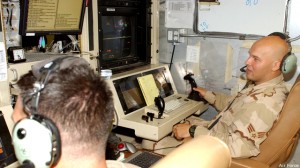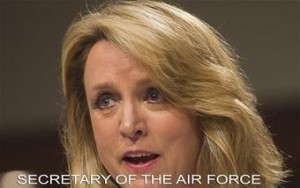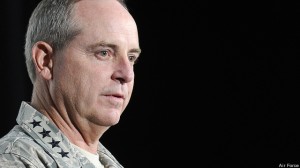Drones Need Humans, Badly; Pilots Getting More Dough
Posted on

MQ-9 Reaper drone.
WASHINGTON: Even unmanned aircraft need people to make them fly. Today, Air Force Secretary Deborah Lee James announced stopgap measures to shore up overworked drone squadrons. At the same press conference, the service’s Chief of Staff pledged to plug another personnel gap, the shortage of skilled maintainers for the manned F-35 — but, Gen. Mark Welsh admitted, the expedients required would be “painful.”
So even in the service most enamored of technology, the knottiest problems sometimes still turn out to be old-fashioned human beings.
The MQ-1 Predator and its big brother, the MQ-9 Reaper, have become pop culture icons of modern warfare, but pop culture forgets how labor-intensive they are to operate. Not only do they need maintenance crews, intelligence analysts, and sensor operators, each drone requires a human pilot flying it by remote control every second it’s in the air. That’s why the Air Force prefers the term Remotely Piloted Aircraft or RPA. (More advanced drones like the Global Hawk and Triton require less constant hand-holding). All those humans are under stress today, but none more so than the pilots.

Predator drone operators.
“Last June, I visited Creech Air Force Base and saw our remotely piloted ISR mission first-hand,” James said at the Pentagon today. Demand for drones in the Mideast didn’t’ drop as a expected because of the escalating war with the Islamic State. As a result, “this is a force that is under significant stress [from] an unrelenting pace of operations,” she said, “working six days in a row… 13-14 hour days on average.” On average, she said, an RPA pilot flies four times as many hours as the pilots of manned aircraft.
“We’ve been working the RPA retention issues for the entire force for a while now, [but] the crisis right now is with the pilot force,” added Gen. Welsh. That’s partly because they require the longest and most complex training, partly because of ever-rising operational demands, and partly because the overworked operational units keep sucking in pilots needed as instructors. The Air Force has only 63 percent of the RPA trainers it needs, said Welsh, and many of those instructors spend much of their time flying operational missions instead of training new personnel, creating a vicious cycle of shortages. As a result, the Air Force calculates it needs to train about 300 new RPA pilots a year but is only producing 180 — and losing 240.
Now, the crisis is coming to a head because of a quirk of service contracts: “Many of our most experienced operators are nearing the end of their active duty service commitment,” said James. “That means they have a choice” — and many may choose to go.

Air Force Secretary Deborah Lee James
“Our plan is designed to immediately relieve some of this strain,” James said, even as the service works on longer-term solutions that may require relief from Congress.
Part one is more money. James is using her existing authority to more than double monthly incentive pay for RPA pilots from $650 to $1,500. While the total amount is modest for the service as a whole, for an individual Air Force family that’s over $10,000 extra a year. In the longer run, James wants new authority for new incentives. Especially important would be letting RPA pilots who re-up receive “aviation continuation pay,” a benefit of up to $25,000 a year that’s currently restricted to manned aircraft pilots only.
Part two is more people. The Air Force will call up more Air National Guard and Air Force Reserve personnel to fill out the ranks of the RPA force. It will ask RPA pilots currently scheduled to move on to other assignments to “volunteer” to stay in drones instead: Gen. Welsh said there are “33 we’re going to ask to stay” — but when a four-star goes into that level of detail, you can imagine the pressure those 33 will be under. The Air Force will also ask RPA-qualified pilots who’ve already moved on to come back to drone units.
“These are first steps,” James emphasized.
In the longer run, the Air Force wants to pick up qualified personnel from other services that are downsizing (i.e. the Army). It might even break a century of tradition and allow enlisted personnel to be pilots, albeit only of drones. (The Air Force and Navy only allow commissioned officers to fly; the Army has long used warrant officers in helicopters and employs enlisted personnel for drones). “Yes, we should look at the enlisted force,” Welsh said. “There’re some pluses and minuses…. I’ll come to the boss with some recommendations in the relatively near future.”
One thing to remember. The Air Force was warned in April about these problems by the Government Accountability Office, which recommended steps to repair the problems. Also, the service has struggled to keep pilots for years, so this isn’t something that popped up and bit the service in the butt..
For now, however, Air Force enlisted personnel almost all work on the ground, for example as maintainers. That’s the skillset where F-35 faces its painful shortage.
The Air Force originally planned to free up both funding and personnel for the F-35 fleet by retiring the venerable A-10 Warthog, but Congress refused to scrap the beloved ground-attack plane. That meant the service has to find enough maintainers to keep up both the aging A-10s and the new F-35s. At one point, program manager Lt. Gen. Chris Bogdan warned the personnel shortage might prevent the Air Force’s F-35A, from reaching Initial Operational Capability on time.

Gen. Mark Welsh
“We will have enough,” Gen. Welsh said today. The F-35A will reach IOC on schedule between August and December of 2016, he promised. A delay is unacceptable, he said: “We will do everything we can to come up with other solutions that are painful in different ways to try not to do that.”
What those “painful” solutions are, Welsh didn’t detail. At least some of them will require congressional approval, it seems. “If the proposals we come forward with are not agreed to, IOC is at risk,” Welsh said, before emphasizing his staff had been working closely with Capitol Hill.
F-35s and Predators are just some of the Air Force’s highest-profile personnel shortages, however. James also said she had “redirected” 1,100 personnel from other fields to fill critical specialties in the long-neglected nuclear force.
Overall, “we are undermanned in lots of areas of our Air Force,” the secretary said. “We have now downsized as much as we can…. We simply cannot do more.”
Colin contributed to this story.
Subscribe to our newsletter
Promotions, new products and sales. Directly to your inbox.
